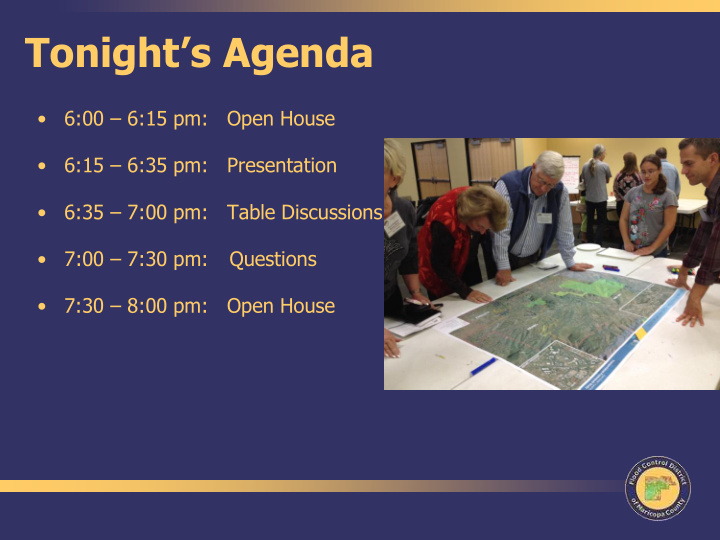



Tonight’s Agenda • 6:00 – 6:15 pm: Open House • 6:15 – 6:35 pm: Presentation • 6:35 – 7:00 pm: Table Discussions • 7:00 – 7:30 pm: Questions • 7:30 – 8:00 pm: Open House
PINNACLE PEAK WEST AREA DRAINAGE MASTER STUDY Rawhide Wash Community Meeting May 11, 2015
Tonight’s Presentation • Study Results • Focus on Rawhide Wash – Options • Discussion/Input • Questions
Flood Control District of Maricopa County MISSION: Reduce county resident’s risks of injury, death, and property damage due to flooding Major Activities o Floodplain & Watershed Studies o Floodplain Regulation o Flood Hazard Mitigation Structural • Non-structural • o Operations & Maintenance Dams, channels, levees, and basins •
Study Goal: Reduce Flood Risk 1. Identify flood hazards Water depths, locations, flow, • and speed 2. Determine if the hazard poses a risk to buildings, vehicles and people 3. Develop options to reduce Salt River: Avg Flow 1400 cfs the high risk problems
PPW ADMS Characteristics: 95 square miles Jurisdiction Scottsdale 46% Phoenix 45% Unincorporated 8% Land Ownership Private 48.7% AZ State Land 41.4% Federal 3.8% Project Partners Existing Floodplains Two Focus Areas
Modeling Results • Based on 4-5 inches of rain in 24 hours – 1% chance (i.e. 100 year storm) Houses & Buildings • Over 1900 at potential risk – 60% located outside of mapped floodplain – Over 230 will have 18 inches or higher of water on property
Transportation Hazards • Based on depth & velocity • 100-yr Storm (4- 5” rain): 1 in 5 streets dangerous or impassible • 10-yr Storm (2.5- 3” rain): 100 locations impassible
School/Pedestrian Risks • Locations with deep and fast water that can knock people off their feet • 575 locations identified – Washes – Near houses – Schools • 10 schools may have limited Pedestrians Rescued from Indian Bend Wash - 2014 access during large storms
What Can You Do? • Know your risk – View on computers in open-house – Website • Consider buying flood insurance • Structural fixes • Floodproofing • Landscaping, grading, and erosion protection
FOCUS AREA: Rawhide Wash
Rawhide Wash Specific Results • Active Alluvial Fan Floodplain • Approximately 4,000 properties in floodplain – Flood insurance required (mortgaged houses) – $1.6 Million annually • 500 houses & buildings at potential risk
Rawhide Wash Hazards: High Flows • 100-year Flow: 9,600 cubic feet per second (cfs) - Colorado River at Lee’s Ferry • Highest recorded flow: 440 cfs in September 2006 18-foot raft in Grand Canyon at ~ 10,000 cfs • Sediment
Model Results • Animation
Rawhide Wash Hazards: Wash is Unpredictable
3 Options for Discussion Developed based on input received at last meeting and technical analysis Fact Sheet available 1. No Action 2. No Build 3. Build
NO ACTION • Nothing changes – Accept the risk • 4,000 properties remain in floodplain • 500 structures at potential risk • High costs to Property Owners – Flood Insurance – Existing & Future – Development Costs
NO BUILD • Remap floodplain – Pending FEMA approval – Not sure of outcome – Some properties will be outside of revised floodplain • Risk remains same as today • High costs to Property Owners – Flood Insurance – Existing & Future – Development Costs
BUILD • Build structures to reduce the risk & size of floodplain – Addresses uncertainty – Levee, floodwalls, basin, and grade control structures – Floodplain would be remapped to remove floodplain for about 3,400 properties • Moderate costs – Cities & County – Future Developers
What do you think? • Help us identify additional pros and cons of the 3 options • Table Exercise: – Use sticky note pad and markers – Post your comments under each option – Discuss with others at your table – Share with other participants
Next Steps: • Review your comments on the 3 options • Conduct further technical analysis • In collaboration with partners, select an option for moving forward • If build option is chosen, additional meetings will be held to discuss alternatives
QUESTIONS? • Go to computer station to determine if your property is at risk • See project team members to discuss issues specific to your property • Complete your comment form
Open House: 7:30-8:00 pm • Review results – Maps and Exhibits – Computer Stations • General flooding information – Exhibits – Handouts – Cities of Phoenix and Scottsdale • Provide Input – Flooding Resource Guide – General comments
Recommend
More recommend